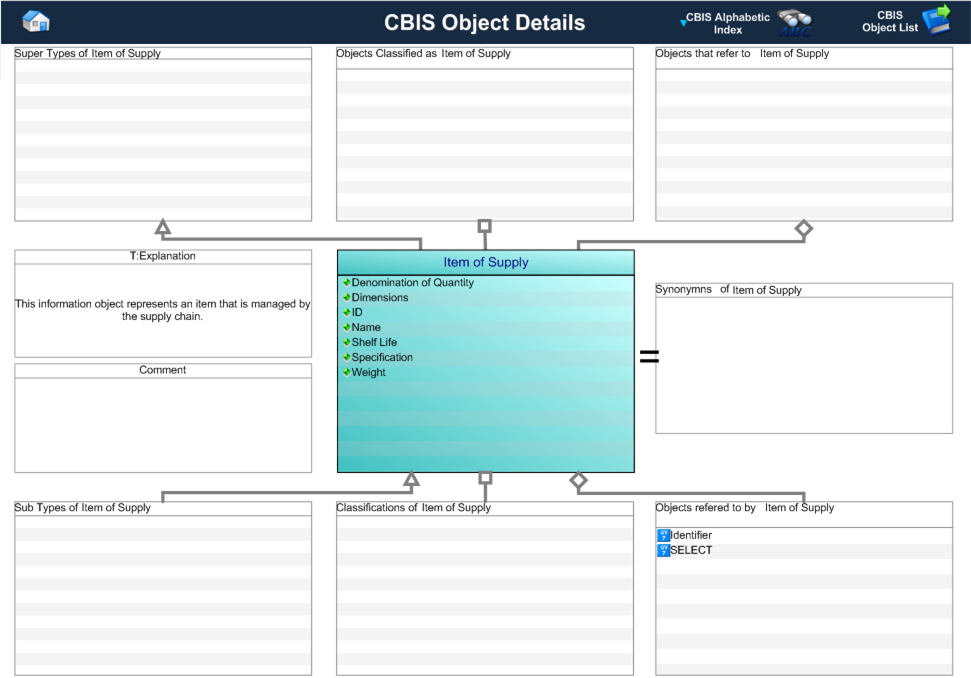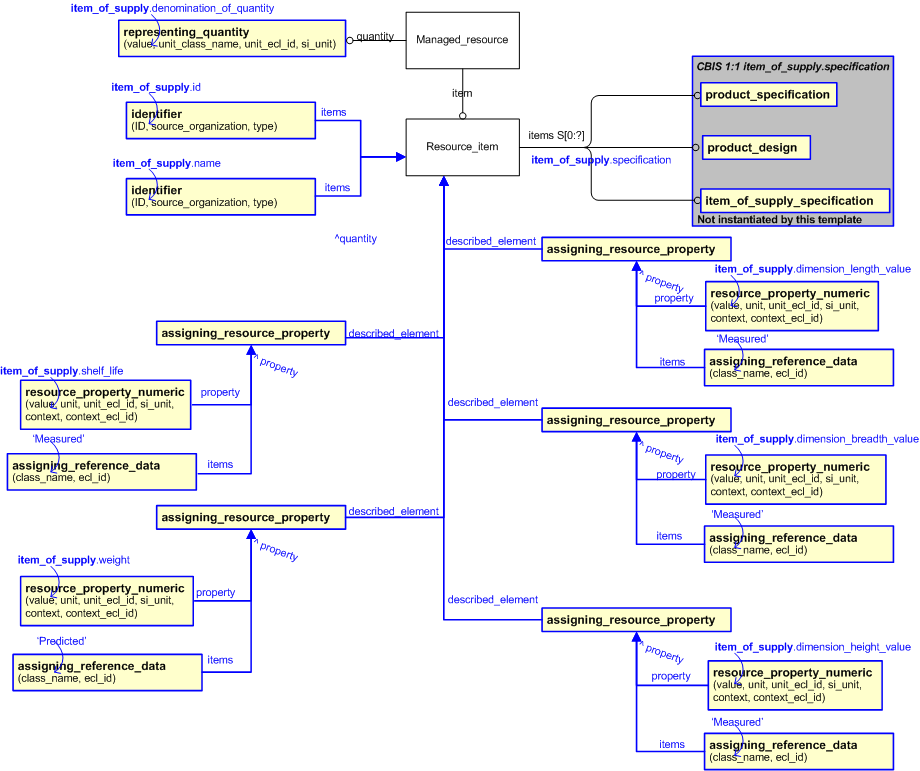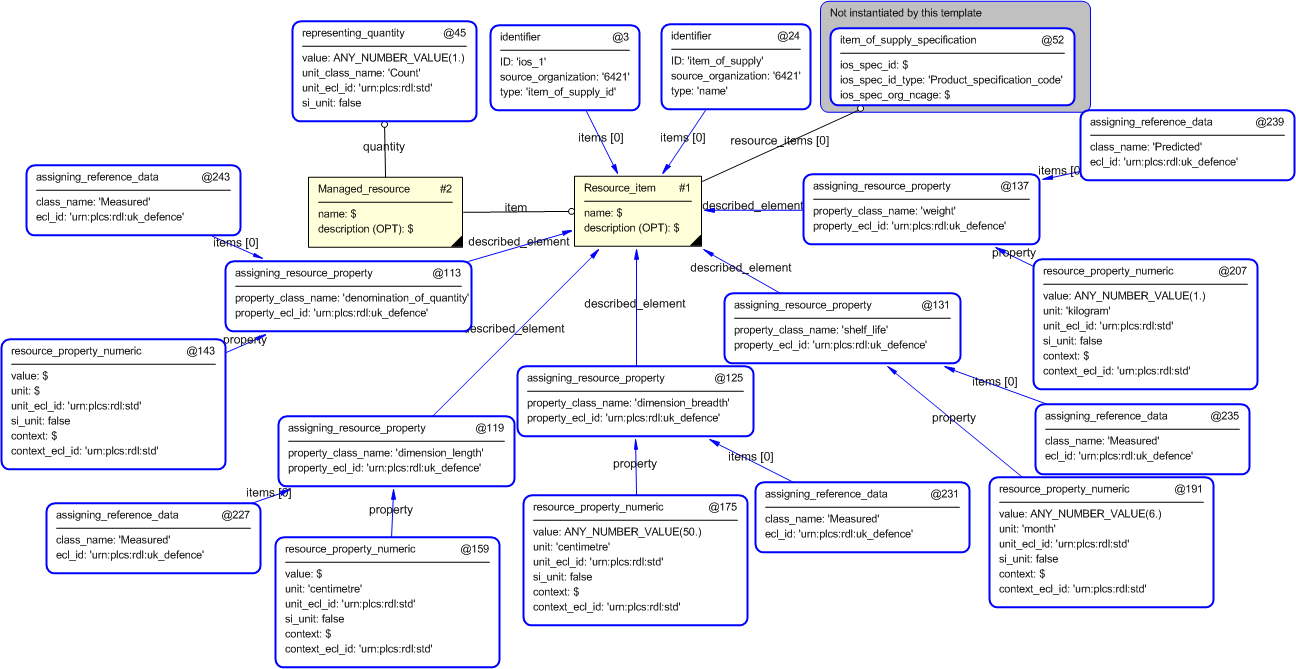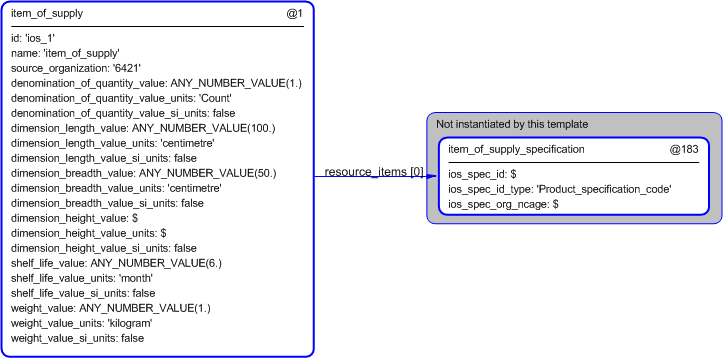Template:— item_of_supply (IoS)
Context:— UK_Defence |
Date: 2010/02/17 17:12:07
Revision: 1.11
|
This section specifies the template item_of_supply.
NOTE
The template has been defined in the context of
UK_Defence.
Refer to the business context for details of related templates.
NOTE
An explanation of a template and the associated instantiation path is
provided in the
Template overview
section.
This template describes how to represent an item that is managed by the supply chain.
Figure 1 — Graphical Representation for Business Object item_of_supply
item_of_supply
The definition of a item_of_supply object is:
This information object represents information about an an item that is managed by the supply chain.
|
Attribute name
|
Attribute description
|
Attribute type
|
Optionality
|
| Denomination of Quantity |
The quantity that represents a unit of purchase. |
intrinsic |
Mandatory |
| Dimensions |
This specifies the dimensions of the item of supply. |
intrinsic |
Mandatory |
| ID |
This is the identifier of the item of supply. |
Identifier |
Mandatory |
| Identifier.id |
This is the value of the id attribute of the Identifier applied to the item of supply. |
intrinsic |
Mandatory |
| Identifier.type |
This attribute is the type associated with the id of the Identifier given to the item of supply. |
item_of_supply_id |
Mandatory |
| Identifier.source_organization |
This attribute is the value representing the source organization that provides the id of the Identifier given to the item
of supply. This value is assumed to be a type of Organization_identification_code.
|
Organization_identification_code |
Mandatory |
| Name |
This is the name of the item of supply. |
intrinsic |
Mandatory |
| Shelf Life |
This is the standard shelf life of the item of the supply. |
intrinsic |
Mandatory |
| Specification |
This is the reference to the specification of the item of supply. This can either be a NATO codified item, a part numbered
item or another form of item specification.
|
Relationship to Product Specification, Product Design or Item of Supply Specification |
Mandatory |
| Weight |
This is the weight of the item of supply. |
intrinsic |
Mandatory |
Table 1 — item_of_supply attribute details
The EXPRESS-G diagram in
Figure
2
shows the templates and EXPRESS entities that are required
to represent the template
"item_of_supply".
The text highlighted in blue shows the template parameters.
Figure 2 — An EXPRESS-G representation of the Information model for Item_of_supply
The graphic for the template to be used in other EXPRESS-G diagrams
is shown in Figure
3
below.
Figure 3 — The graphical representation of the Item_of_supply template
The following input parameters are defined for this template:
This is the reference to the specification of the item of supply.
This can either be a NATO codified item, a part numbered item or another form of item specification.
This is the identifier of the item of supply.
This is the name of the item of supply.
An Organization representing the identification/rectification authority for the failure.
The quantity that represents a unit of purchase.
The required value assigned to a denomination.
The following classes and their sub-classes can be used:
Value should be set to true if the unit is a SI base unit defined by ISO, i.e.
kilogram (kg) for Mass,
second (s) for Time,
metre (m) for Displacement,
ampere (A) for Electrical current,
kelvin (K) for Temperature,
mole (mol) for Amount of substance, and
candela (cd) for Luminous intensity. If this is not the case it should be set to false.
Note that the representation of true and false depends on exchange format. In Part 11 (a STEP file) true is
represented by the string ".T.", and false by ".F.", while in Part 28 (XML) they are represented by text strings
"true"
and "false".
This specifies the length dimension of the item of supply.
The required value units assigned to the dimension.
The following classes and their sub-classes can be used:
Value should be set to true if the unit is a SI base unit defined by ISO, i.e.
kilogram (kg) for Mass,
second (s) for Time,
metre (m) for Displacement,
ampere (A) for Electrical current,
kelvin (K) for Temperature,
mole (mol) for Amount of substance, and
candela (cd) for Luminous intensity. If this is not the case it should be set to false.
Note that the representation of true and false depends on exchange format. In Part 11 (a STEP file) true is
represented by the string ".T.", and false by ".F.", while in Part 28 (XML) they are represented by text strings
"true"
and "false".
This specifies the breadth dimension of the item of supply
The required value units assigned to the dimension.
The following classes and their sub-classes can be used:
Value should be set to true if the unit is a SI base unit defined by ISO, i.e.
kilogram (kg) for Mass,
second (s) for Time,
metre (m) for Displacement,
ampere (A) for Electrical current,
kelvin (K) for Temperature,
mole (mol) for Amount of substance, and
candela (cd) for Luminous intensity. If this is not the case it should be set to false.
Note that the representation of true and false depends on exchange format. In Part 11 (a STEP file) true is
represented by the string ".T.", and false by ".F.", while in Part 28 (XML) they are represented by text strings
"true"
and "false".
This specifies the height dimension of the item of supply.
The required value units assigned to the dimension.
The following classes and their sub-classes can be used:
Value should be set to true if the unit is a SI base unit defined by ISO, i.e.
kilogram (kg) for Mass,
second (s) for Time,
metre (m) for Displacement,
ampere (A) for Electrical current,
kelvin (K) for Temperature,
mole (mol) for Amount of substance, and
candela (cd) for Luminous intensity. If this is not the case it should be set to false.
Note that the representation of true and false depends on exchange format. In Part 11 (a STEP file) true is
represented by the string ".T.", and false by ".F.", while in Part 28 (XML) they are represented by text strings
"true"
and "false".
This is the standard shelf life of the item of the supply.
The required value units assigned to the shelf life.
The following classes and their sub-classes can be used:
Value should be set to true if the unit is a SI base unit defined by ISO, i.e.
kilogram (kg) for Mass,
second (s) for Time,
metre (m) for Displacement,
ampere (A) for Electrical current,
kelvin (K) for Temperature,
mole (mol) for Amount of substance, and
candela (cd) for Luminous intensity. If this is not the case it should be set to false.
Note that the representation of true and false depends on exchange format. In Part 11 (a STEP file) true is
represented by the string ".T.", and false by ".F.", while in Part 28 (XML) they are represented by text strings
"true"
and "false".
This is the weight of the item of supply.
The required value units assigned to the weight.
The following classes and their sub-classes can be used:
Value should be set to true if the unit is a SI base unit defined by ISO, i.e.
kilogram (kg) for Mass,
second (s) for Time,
metre (m) for Displacement,
ampere (A) for Electrical current,
kelvin (K) for Temperature,
mole (mol) for Amount of substance, and
candela (cd) for Luminous intensity. If this is not the case it should be set to false.
Note that the representation of true and false depends on exchange format. In Part 11 (a STEP file) true is
represented by the string ".T.", and false by ".F.", while in Part 28 (XML) they are represented by text strings
"true"
and "false".
The following reference parameters are defined for this template:
Allow the
Resource_item
entity instantiated in this path to be referenced when this template is used.
Note: The
Resource_item
entity can be referenced in a template path by:
%^target = $item_of_supply.item_of_supply%
where
target
is the parameter to which the
Resource_item
is bound.
The instantiation path shown below specifies the entities that are to be
instantiated by the template.
A description of templates and the syntax for the instantiation path is
provided in the
Templates Help/Information section.
-- Create the Item of Supply Managed_resourceManaged_resource.name = '/IGNORE'
Managed_resource.description = '/IGNORE'
Resource_itemResource_item.name = '/IGNORE'
Resource_item.description = '/IGNORE'
Managed_resource.item ->
Resource_item%^managed_item_of_supply =
Managed_resource%
%^item_of_supply =
Resource_item%
Resource_item.resource_items ->
@specification-- identifier /
identifier(
ID=@id,
source_organization=@source_organization,
type='item_of_supply_id',
items=^item_of_supply)/
-- name /
identifier(
ID=@name,
source_organization=@source_organization,
type='name',
items=^item_of_supply)/
-- Denomination of Quantity /
representing_quantity(
value=@denomination_of_quantity_value,
si_unit=@denomination_of_quantity_value_si_units,
unit_class_name=@denomination_of_quantity_value_units,
unit_ecl_id='urn:plcs:rdl:std')/
^managed_item_of_supply.quantity -> $representing_quantity.quantity
-- dimensions - length -- Property ID and A property of /
assigning_resource_property(
property_class_name='dimension_length',
property_ecl_id='urn:plcs:rdl:UK_Defence',
described_element=^item_of_supply)/
-- Assign reference parameter %^dimension_length = $assigning_resource_property.property%
-- Value and Unit /
resource_property_numeric(
value=@dimension_length_value,
unit=@dimension_length_value_units,
unit_ecl_id='urn:plcs:rdl:std',
si_unit=@dimension_length_value_si_units,
context='Numerical_representation_context',
context_ecl_id='urn:plcs:rdl:std',
property=^dimension_length)/
-- Disposition /
assigning_reference_data(
class_name='Measured',
ecl_id='urn:plcs:rdl:UK_Defence',
items=^dimension_length)/
-- dimensions - breadth -- Property ID and A property of /
assigning_resource_property(
property_class_name='dimension_breadth',
property_ecl_id='urn:plcs:rdl:UK_Defence',
described_element=^item_of_supply)/
-- Assign reference parameter %^dimension_breadth = $assigning_resource_property.property%
-- Value and Unit /
resource_property_numeric(
value=@dimension_breadth_value,
unit=@dimension_breadth_value_units,
unit_ecl_id='urn:plcs:rdl:std',
si_unit=@dimension_breadth_value_si_units,
context='Numerical_representation_context',
context_ecl_id='urn:plcs:rdl:std',
property=^dimension_breadth)/
-- Disposition /
assigning_reference_data(
class_name='Measured',
ecl_id='urn:plcs:rdl:UK_Defence',
items=^dimension_breadth)/
-- dimensions - height -- Property ID and A property of /
assigning_resource_property(
property_class_name='dimension_height',
property_ecl_id='urn:plcs:rdl:UK_Defence',
described_element=^item_of_supply)/
-- Assign reference parameter %^dimension_height = $assigning_resource_property.property%
-- Value and Unit /
resource_property_numeric(
value=@dimension_height_value,
unit=@dimension_height_value_units,
unit_ecl_id='urn:plcs:rdl:std',
si_unit=@dimension_height_value_si_units,
context='Numerical_representation_context',
context_ecl_id='urn:plcs:rdl:std',
property=^dimension_height)/
-- Disposition /
assigning_reference_data(
class_name='Measured',
ecl_id='urn:plcs:rdl:UK_Defence',
items=^dimension_height)/
-- shelf life -- Property ID and A property of /
assigning_resource_property(
property_class_name='shelf_life',
property_ecl_id='urn:plcs:rdl:UK_Defence',
described_element=^item_of_supply)/
-- Assign reference parameter %^shelf_life = $assigning_resource_property.property%
-- Value and Unit /
resource_property_numeric(
value=@shelf_life_value,
unit=@shelf_life_value_units,
unit_ecl_id='urn:plcs:rdl:std',
si_unit=@shelf_life_value_si_units,
context='Numerical_representation_context',
context_ecl_id='urn:plcs:rdl:std',
property=^shelf_life)/
-- Disposition /
assigning_reference_data(
class_name='Measured',
ecl_id='urn:plcs:rdl:UK_Defence',
items=^shelf_life)/
-- weight -- Property ID and A property of /
assigning_resource_property(
property_class_name='weight',
property_ecl_id='urn:plcs:rdl:UK_Defence',
described_element=^item_of_supply)/
-- Assign reference parameter %^weight = $assigning_resource_property.property%
-- Value and Unit /
resource_property_numeric(
value=@weight_value,
unit=@weight_value_units,
unit_ecl_id='urn:plcs:rdl:std',
si_unit=@weight_value_si_units,
context='Numerical_representation_context',
context_ecl_id='urn:plcs:rdl:std',
property=^weight)/
-- Disposition /
assigning_reference_data(
class_name='Predicted',
ecl_id='urn:plcs:rdl:UK_Defence',
items=^weight)/
The following entities are instantiated with attributes as specified:
The instance diagram in Figure
4
shows an example of the EXPRESS entities and templates that are instantiated by the template:
/Item_of_supply(specification='#52', id='ios_1', name='item_of_supply', source_organization='6421', denomination_of_quantity_value='1', denomination_of_quantity_value_units='', denomination_of_quantity_value_si_units='false', dimension_of_length_value='100', dimension_of_length_value_units='centimetre', dimension_of_length_value_si_units='false', dimension_of_breadth_value='50', dimension_of_breadth_value_units='centimetre', dimension_of_breadth_value_si_units='false', dimension_of_height_value='50', dimension_of_height_value_units='centimetre', dimension_of_height_value_si_units='false', shelf_life_value='6', shelf_life_value_units='month', shelf_life_value_si_units='false', weight_value='1', weight_value_units='kilogram', weight_value_si_units='false')/
(an illustration of the consolidated Item_of_supply template is shown in
Figure
5 below.)
Figure 4 — Entities instantiated by Item_of_supply template
The instance diagram in
Figure
5
shows the graphic symbol for the template that is to be
used in other instance diagrams. The example template is:
/Item_of_supply(specification='#52', id='ios_1', name='item_of_supply', source_organization='6421', denomination_of_quantity_value='1', denomination_of_quantity_value_units='', denomination_of_quantity_value_si_units='false', dimension_of_length_value='100', dimension_of_length_value_units='centimetre', dimension_of_length_value_si_units='false', dimension_of_breadth_value='50', dimension_of_breadth_value_units='centimetre', dimension_of_breadth_value_si_units='false', dimension_of_height_value='50', dimension_of_height_value_units='centimetre', dimension_of_height_value_si_units='false', shelf_life_value='6', shelf_life_value_units='month', shelf_life_value_si_units='false', weight_value='1', weight_value_units='kilogram', weight_value_si_units='false')/
Figure 5 — Instantiation of Item_of_supply template
Characterizations
No common characterizations of the template
item_of_supply
have been identified. However, the ISO 10303-239 EXPRESS model
may enable other assignments to the entities instantiated by the template.




